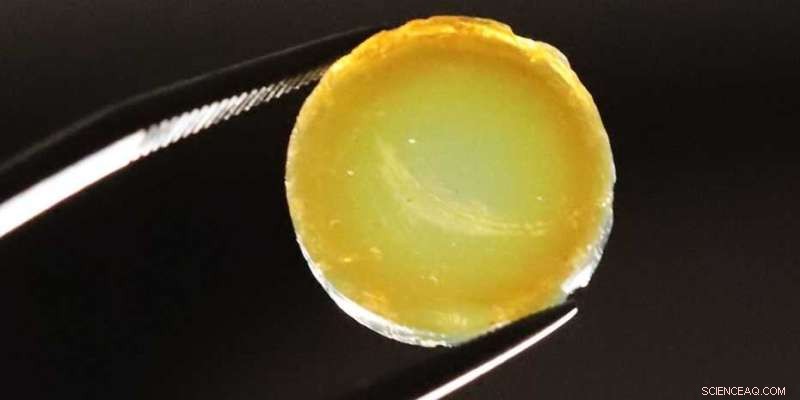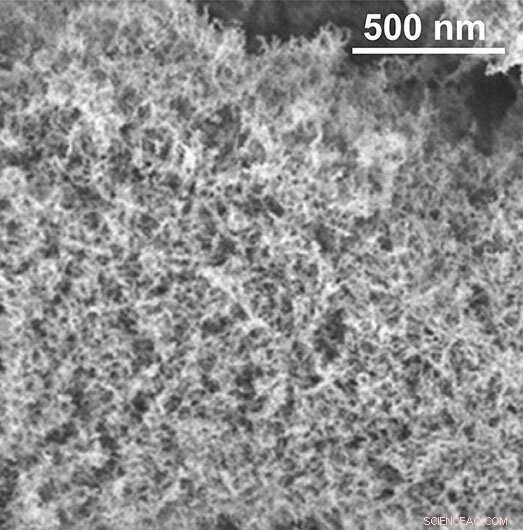
Un aérogel en forme de comprimé composé de nanoparticules de TiO2 dopées au palladium et à l'azote. Crédit :Markus Niederberger / ETH Zurich
Les aérogels sont des matériaux extraordinaires qui ont établi des records du monde Guinness plus d'une douzaine de fois, notamment en tant que solides les plus légers au monde.
Le professeur Markus Niederberger du Laboratoire des matériaux multifonctionnels de l'ETH Zurich travaille depuis un certain temps avec ces matériaux spéciaux. Son laboratoire est spécialisé dans les aérogels composés de nanoparticules semi-conductrices cristallines. "Nous sommes le seul groupe au monde capable de produire ce type d'aérogel avec une qualité aussi élevée", déclare-t-il.
Une utilisation des aérogels à base de nanoparticules est comme photocatalyseurs. Ceux-ci sont utilisés chaque fois qu'une réaction chimique doit être activée ou accélérée à l'aide de la lumière du soleil, par exemple la production d'hydrogène.
Le matériau de choix pour les photocatalyseurs est le dioxyde de titane (TiO2 ), un semi-conducteur. Mais TiO2 présente un inconvénient majeur :il ne peut absorber que la partie UV de la lumière solaire, soit environ 5 % du spectre. Pour que la photocatalyse soit efficace et utile sur le plan industriel, le catalyseur doit pouvoir utiliser une gamme plus large de longueurs d'onde.
Élargir le spectre avec le dopage à l'azote
C'est pourquoi le doctorant de Niederberger, Junggou Kwon, a cherché une nouvelle façon d'optimiser un aérogel à base de TiO2 nanoparticules. Et elle a eu une idée géniale :si le TiO2 L'aérogel de nanoparticules est "dopé" (pour utiliser le terme technique) avec de l'azote, de sorte que les atomes d'oxygène individuels du matériau sont remplacés par des atomes d'azote, l'aérogel peut alors absorber d'autres parties visibles du spectre. Le processus de dopage laisse intacte la structure poreuse de l'aérogel. L'étude sur cette méthode a été récemment publiée dans la revue Applied Materials &Interfaces .
Kwon a d'abord produit l'aérogel en utilisant TiO2 des nanoparticules et de petites quantités de palladium, un métal noble qui joue un rôle clé dans la production photocatalytique d'hydrogène. Elle a ensuite placé l'aérogel dans un réacteur et l'a infusé avec du gaz ammoniac. Cela a provoqué l'intégration d'atomes d'azote individuels dans la structure cristalline du TiO2 nanoparticules.

La structure interne en forme d'éponge de l'aérogel. Crédit :Laboratoire des matériaux multifonctionnels / ETH Zurich
L'aérogel modifié rend la réaction plus efficace
To test whether an aerogel modified in this way actually increases the efficiency of a desired chemical reaction—in this case, the production of hydrogen from methanol and water—Kwon developed a special reactor into which she directly placed the aerogel monolith. She then introduced a vapor of water and methanol to the aerogel in the reactor before irradiating it with two LED lights. The gaseous mixture diffuses through the aerogel's pores, where it is converted into the desired hydrogen on the surface of the TiO2 and palladium nanoparticles.
Kwon stopped the experiment after five days, but up to that point, the reaction was stable and proceeded continuously in the test system. "The process would probably have been stable for longer," Niederberger says. "Especially with regard to industrial applications, it's important for it to be stable for as long as possible." The researchers were satisfied with the reaction's results as well. Adding the noble metal palladium significantly increased the conversion efficiency:using aerogels with palladium produced up to 70 times more hydrogen than using those without.
Increasing the gas flow
This experiment served the researchers primarily as a feasibility study. As a new class of photocatalysts, aerogels offer an exceptional three-dimensional structure and offer potential for many other interesting gas-phase reactions in addition to hydrogen production. Compared to the electrolysis commonly used today, photocatalysts have the advantage that they could be used to produce hydrogen using only light rather than electricity.
Whether the aerogel developed by Niederberger's group will ever be used on a large scale is still uncertain. For example, there is still a question of how to accelerate the gas flow through the aerogel; at the moment, the extremely small pores hinder the gas flow too much. "To operate such a system on an industrial scale, we first have to increase the gas flow and also improve the irradiation of the aerogels," Niederberger says. He and his group are already working on these issues.
Aerogels are exceptional materials. They are extremely light and porous, and boast a huge surface area:one gram of the material can have a surface area of up to 1,200 square meters. Due to their transparency, aerogels have the appearance of "frozen smoke." They are excellent thermal insulators and so are used in aerospace applications and, increasingly, in the thermal insulation of buildings as well. However, their manufacture still requires a huge amount of energy, so the materials are expensive. The first aerogel was produced from silica by the chemist Samuel Kistler in 1931. + Explorer plus loin